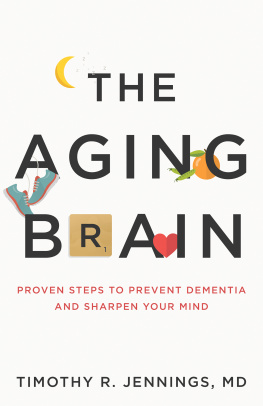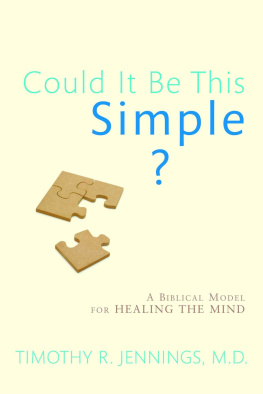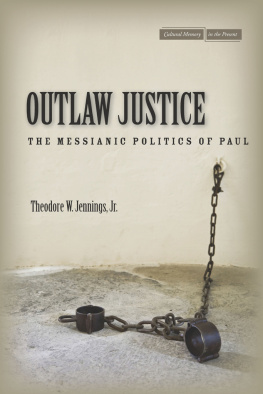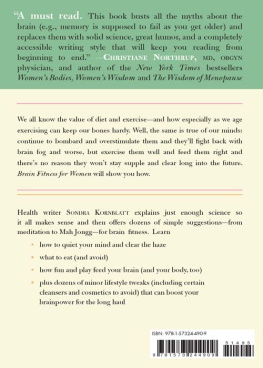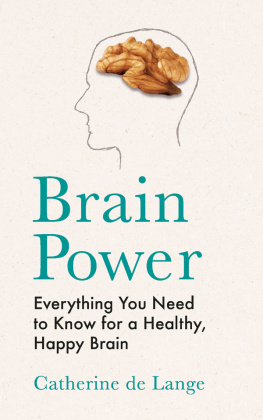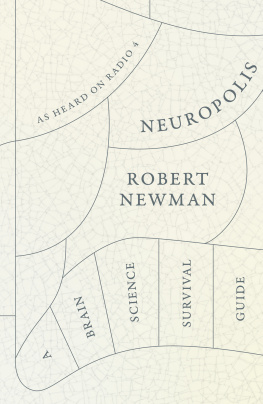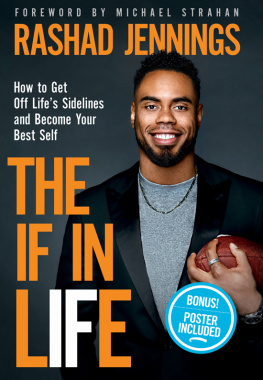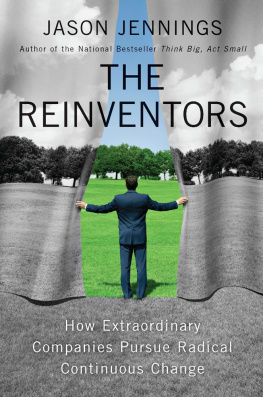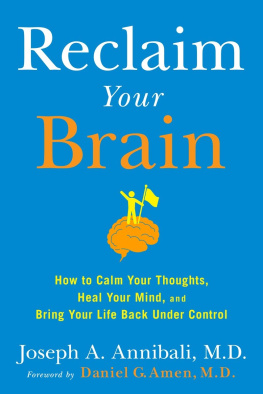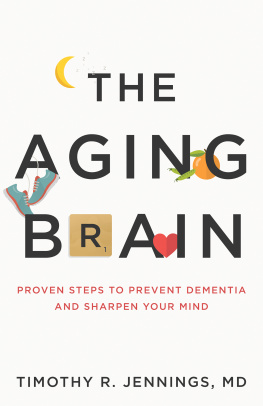The God-Shaped Brain
How Changing Your View of God Transforms Your Life
Timothy R. Jennings, M.D.

www.IVPress.com/ books
InterVarsity Press
P.O. Box 1400
Downers Grove, IL 60515-1426
World Wide Web: www.ivpress.com
E-mail: email@ivpress.com
2013 by Timothy R. Jennings, M.D.
All rights reserved. No part of this book may be reproduced in any form without written permission from InterVarsity Press.
InterVarsity Press is the book-publishing division of InterVarsity Christian Fellowship/USA, a movement of students and faculty active on campus at hundreds of universities, colleges and schools of nursing in the United States of America, and a member movement of the International Fellowship of Evangelical Students. For information about local and regional activities, write Public Relations Dept. InterVarsity Christian Fellowship/USA, 6400 Schroeder Rd., P.O. Box 7895, Madison, WI 53707-7895, or visit the IVCF website at www.intervarsity.org.
All Scripture quotations, unless otherwise indicated, are taken from THE HOLY BIBLE, NEW INTERNATIONAL VERSION, NIV Copyright 1973, 1978, 1984, 2011 by Biblica, Inc. Used by permission. All rights reserved worldwide.
Image of the human brain on p. 7 used with permission from Simon Harrison
While all stories in this book are true, some names and identifying information in this book have been changed to protect the privacy of the individuals involved.
Published in association with the literary agency of D. C. Jacobson & Associates, Lake Oswego, Oregon. www.dcjacobson.com
Cover Design: Cindy Kiple
Images: Head with gear inside: CSA Images/Color Printstock Collection/Getty Images Atom: Yulia Glam/iStockphoto
ISBN 978-0-8308-8431-5 (digital)
ISBN 978-0-8308-3416-7 (print)
Contents
Section I
God, the Brain and What Went Wrong
Section II
The Battle Between The Conflicting Views About God
Section III
Embracing the Goodness of God
Addendum
Putting It All Together Simple Steps to a Healthier Brain
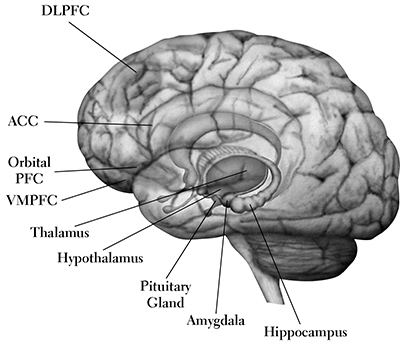
Diagram of the human brain
Preface
The thing always happens that you really believe in; and the belief in a thing makes it happen.
Frank Lloyd Wright
Recently, my eleven-year-old nephew and fourteen-year-old niece, who have not been raised in a churchgoing family, attended church. The sermon was a discourse on Gods wrath and was delivered with a fiery intensity designed to shock and awe. After this searing exhortation, both came home distraught and reported that the preacher presented a god that scared themone that, if true, they would never want to believe in.
I wondered, Would Jesus be happy if we presented him in such a way that the children would not want to be with him or know him? Isnt something wrong if in talking about God we frighten the children? Do we help or hurt, heal or injure, when we present a God that incites fear? Does it even matter whether our view of God is good, bad or ugly? It does matter, more than we ever realizedto the point of changing our brain structure! Although we have power over what we believe, what we believe holds real power over uspower to heal and power to destroy.
Late one night in a small Alabama cemetery, Vance Vanders had a run-in with the local witch doctor, who wafted a bottle of unpleasant-smelling liquid in front of his face, and told him he was about to die and that no one could save him.
Back home, Vanders took to his bed and began to deteriorate. Some weeks later, emaciated and near death, he was admitted to the local hospital, where doctors were unable to find a cause for his symptoms or slow his decline. Only then did his wife tell one of the doctors, Drayton Doherty, of the hex.
Doherty thought long and hard. The next morning, he called Vanderss family to his bedside. He told them that the previous night he had lured the witch doctor back to the cemetery, where he had choked him against a tree until he explained how the curse worked. The medicine man had, he said, rubbed lizard eggs into Vanderss stomach, which had hatched inside his body. One reptile remained, which was eating Vanders from the inside out.
Doherty then summoned a nurse who had, by prior arrangement, filled a large syringe with a powerful emetic [a substance which induces vomiting]. With great ceremony, he inspected the instrument and injected its contents into Vanderss arm. A few minutes later, Vanders began to gag and vomit uncontrollably. In the midst of it all, unnoticed by everyone in the room, Doherty produced his pice de rsistancea green lizard he had stashed in his black bag. Look what has come out of you Vance, he cried. The voodoo curse is lifted.
Vanders did a double take, lurched backwards to the head of the bed, then drifted into a deep sleep. When he woke the
Vance is not alone. Medical literature is replete with case reports of patients dying, not from actual illness, but from believing they were sick, from the fear they were going to die. Surgeons routinely avoid operating on patients who are convinced they will die during surgery.
In the 1970s, Sam Shoeman was diagnosed with liver cancer and told he had only months to live. A few months after his death, the autopsy revealed the doctors were wrong. He had only one small tumor still contained within the livernot a life-threatening stage of cancer. Sam Shoeman did not die from liver cancer; he died from believing he was dying of liver cancer.
Our brains are constantly in a state of flux. Moment by moment new neurons are developing and new circuits are being laid down, new axons and dendrites are forming for the facilitating of new messages to the neurons. At the same time, unused connections are removed, dormant nerve tracks are pruned back and unused neurons are deleted. Incredibly, our beliefs, thoughts, behaviors and even our diets change our brain structure, ultimately changing who we are.
Throughout this book we will explore the amazing ability of our brains to adapt, change and rewire based on the choices we make, the beliefs we hold and the God we worshipas different God-concepts affect the brain differently. My goal with this book is to reveal God in the clearest way possible, to demonstrate how our belief in God changes us and to display his methods on a practical level. I also offer a new methodology in the study of God, which I have termed the Integrative Evidence-Based Approach, which incorporates and requires harmony of three threads, Scripture (with special emphasis on the life of Jesus), Gods laws in science and nature, and our experienceall studied with a humble mind under the guidance of the Holy Spirit.
In their book Rediscovering the Scandal of the Cross, Joel Green and Mark Baker observe that our views of God are influenced by the social environment of the times. Then they ask a most pertinent that, if incorporated into our decision making, enable us to determine which are true and which are not. If we study science without Scripture, we risk falling into the ditch of atheistic evolutionism; on the other hand, the study of Scripture separated from Gods laws in nature risks theologies that misrepresent God and distort his character.
To maintain a healthy balance, we must use the Bible and harmonize it with science and our experience to separate the various views of God, demonstrating the marked difference each view has on our mental, physical and relational health. In this book I will explore how a change in ones thinking about God and Scripture results in the healing of mind, body and relationships, while holding to distorted God-concepts bring pain, suffering and, ultimately, death.



